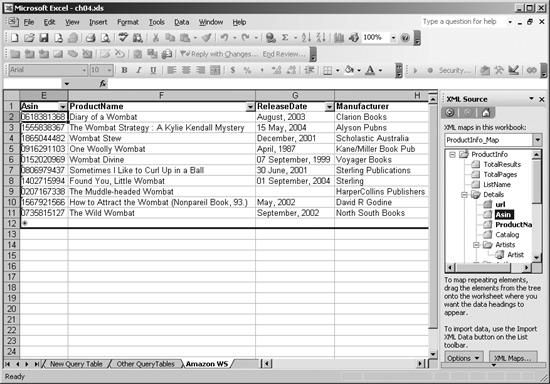Web services from different companies define their interfaces differently. For example, the Google web service provides methods that take simple string arguments, whereas the Amazon web service provides methods that take complex XMLNodeList arguments.
It’s difficult to construct and debug XMLNodeList arguments for the Amazon web service. It’s much easier to invoke this web service directly through its URL and receive the XML response directly.
Note
You don’t have to use the Web Services Toolkit to use web services. In some cases, it’s actually easier to call a web service directly without using the generated proxy classes.
The following code performs a keyword search for books about wombats on Amazon:
Dim SearchUrl As String
' Create a new DOMDocument and set its options
Dim xdoc As New DOMDocument
xdoc.async = True
xdoc.preserveWhiteSpace = True
xdoc.validateOnParse = True
xdoc.resolveExternals = False
' Create the search request
SearchUrl = "http://xml.amazon.com/onca/xml2" & _
"?t=" & "webservices-20" & _
"&dev-t=" & "D1UCR04XBIF4A6" & _
"&page=1" & _
"&f=xml" & _
"&mode=books" & _
"&type=lite" & _
"&KeywordSearch=wombat"
' Issue the request and wait for it to be honored
Loaded = xdoc.Load(SearchUrl)
' Display the results
Debug.Print xdoc.XMLBecause the results are returned as XML, you can create XML map from the result and import the results into a list created from that XML map as shown here:
Set wb = ThisWorkbook
wb.XmlImportXml xdoc.XML, wb.XmlMaps("ProductInfo_Map"), TrueFigure 4-13 displays the result of importing an Amazon search for wombats into a list on a worksheet.
The documentation for the Amazon web service is structured to show you how to call its methods using its URL rather than using proxy classes and SOAP. This means that you don’t have to use the Web Services Toolkit to create proxies for the Amazon web service, just add a reference to the Microsoft XML type library.
This method of accessing a web service is sometimes called Representational State Transfer (REST). That acronym is useful as a search term when looking for this type of interface for a given web service. For instance, type “REST Google API” in a Google search to see an active debate on the relative features of REST and SOAP.
The Google web service doesn’t support direct access through its URL, but you can avoid the proxies and call it directly through SOAP. For example, the following code performs a search for wombats and imports the result through an XML map directly into a list:
Dim soap As New SoapClient30, xn As IXMLDOMNodeList, strXML As String
soap.MSSoapInit "http://api.google.com/GoogleSearch.wsdl"
Set xn = soap.doGoogleSearch("ekN14fFQFHK7lXIW3Znm+VXrXI7Focrl", _
"wombats", 0, 10, False, "", False, "", "", "")
' Build a string containing the results from the search in XML.
strXML = "<GoogleSearchResults>"
For i = 1 To xn.Length - 1
strXML = strXML & xn(i).XML
Next
strXML = strXML & "</GoogleSearchResults>"
' Import the results through an XML Map into a list.
Set wb = ThisWorkbook
wb.XmlImportXml strXML, wb.XmlMaps("GoogleSearchResults_Map"), True| To learn about | Look here |
|---|---|
|
Representational State Transfer (REST) | |
|
http://msdn.microsoft.com/library/en-us/xmlsdk/htm/sdk_intro_6g53.asp | |
|
http://msdn.microsoft.com/library/en-us/xmlsdk/htm/xml_obj_overview_20ab.asp | |
|
http://msdn.microsoft.com/library/en-us/xmlsdk30/htm/xmobjxmldomnodelist.asp |
Get Excel 2003 Programming: A Developer's Notebook now with the O’Reilly learning platform.
O’Reilly members experience books, live events, courses curated by job role, and more from O’Reilly and nearly 200 top publishers.


